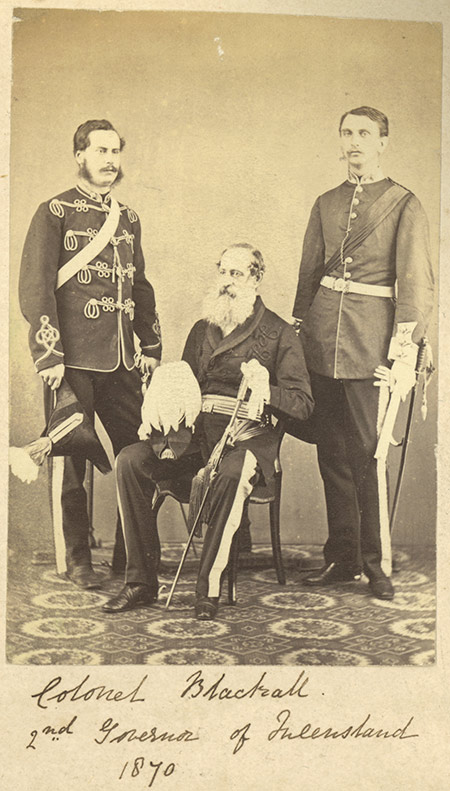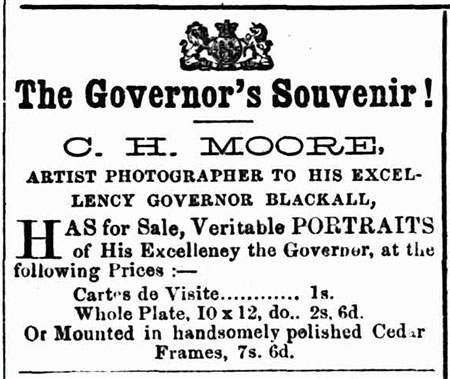Marking time in October 2016
George Verney turns professional
My search for knowledge about my great-great-grand-uncle Daniel Marquis has boosted my interest in the other photographers who were at work in Brisbane in the 1860s and ’70s.
Daniel Marquis set up his photographic studio in Brisbane towards the end of 1865, in George Street, opposite St John’s Pro-Cathedral. He was already a competent operator, with ten years’ experience in Scotland, and he found a ready market for his work in Brisbane. By 1868 he was advertising his position as photographer by appointment to His Excellency Colonel Blackall, the Governor of Queensland. A vice-regal appointment was a mark of competence and respectability.
Governor Blackall lived in Government House at the smarter end of George Street, several blocks southeast from Daniel’s studio, past the upmarket Harris Terrace, the Bellevue Hotel, the Botanical Gardens and the Houses of Parliament.
Blackall’s aide-de-camp was an army officer, Lieutenant George Verney—an amateur photographer. Photography in the wet-plate era was technically difficult, expensive, and mostly the province of professionals.
As an amateur Verney photographed Government House, its residents and visitors. Some of his photographs have survived in an album, now in the National Library of Australia, that give an intimate and personal picture of life in the house. He and Daniel Marquis must have known one another, and I like to imagine them discussing the art and craft of photography.
Governor Blackall stood on the top rung of the social ladder in colonial Queensland. The rank of the principal members of his staff, including George Verney, was elevated by their connection with the person and functions of the governor.

In the 1860s and 1870s the British journal of photography was published weekly. The BJP and its associated annual British journal photographic almanac and photograper’s daily companion were read by professional photographers, and by gentlemen amateurs. George Verney contributed several articles to the Almanac, including the one in the 1877 edition that I quote below. Perhaps he polished and rehearsed this story more than once, as he told it to his fellows in the officers’ mess and in the drawing room at Government House, before he wrote it out and sent it to the editor:
THE AMATEUR AS A PROFESSIONAL
By Capt. George Verney
SOME few years ago I was photographing on the banks of the Mary River, in Queensland, and as assistant I had borrowed the services of the carpenter of the steamer in which I had arrived at Maryborough in attendance on His Excellency, the Governor, as one of his personal staff. I had replaced my uniform by an attire more suitable to the heat of the climate and to my photographic work, and with sleeves rolled up was busy washing a plate when from a neighbouring small house a stout, florid individual stepped out.
Photographers are rare birds in those parts, and, no doubt, it struck my friend that this was a capital opportunity for permanently recording the natural beauty of himself and family—the latter entirely colonial products—and, at the same time, of patronising a vagrant artist. After a few remarks from my friend—who I may call Mr Bounce—delivered in that lofty, patronising tone so suitable to a gentleman of his exalted sphere (though I that evening discovered that he held a very subordinate position in the government service), he condescended to inquire whether I would do a group of himself and family. I replied that I was no portrait artist, but I would try to please him if I could. Mr Bounce intimated that his family should be summoned, but requested me to have everything quite ready, as he could not guarantee his children remaining still long, and in this I soon found out that he spoke the truth.
Such a hullaballoo then ensued ! Such a calling for mother, and Sally, and Tommy, and Harry, and half a dozen more! Such a putting on of coats and hats, of odd boots, of ill-adjusted neckties and pinafores! Such attempts to wash dirty faces clean—the hands were impossible to get clean! Such exercise of parental authority, first from father then from mother, then from both together, distinguished by thumps and smacks, and then by a fiendish howl from the unlucky brat that the plate I had ready in the bath was quite useless! I had to prepare another, while my friend the carpenter was on guard to prevent the children from licking the collodion, and from developing or intensfying themselves all over, or from fixing themselves both in this world and in the next.
When all was ready then came the difficulty of puttmg the children together. I found that the elder children were all anxious to be as far from their parents’ reach as possible, knowing, no doubt, the full weight of parental authority when applied to themselves; while it was equally necessary for the younger ones to be pulling either their father’s beard or their mother’s hair, or disputing which should hold the father’s watch for the baby to listen to the tick, in the hope that this infantile amusement would keep baby still. When intimated that I really could wait no longer the father settled himself with a benign smile on his countenance (which afterwards came out as a diabolical grin), and I hoped that my experience as a professional artist was drawing to a close. But the mother suddenly recollected that baby was not holding the plated mug its grandmother had sent it from England, and as grandmamma was to have a copy of the picture it was absolutely necessary that the mug should be in the baby’s hand. The mother had to go for the mug, leaving the baby in the father’s lap, squalling and kicking as babies will do when their mothers leave them, and suggestmg to my mind how quieting and soporific a dose of cyanide of potassium would be! On returning with the mug baby would not hold it, but dashed it on to the ground, breaking a small bottle of silver I had, which entirely spoiled the appearance of the mug ever after, as before I left It was black all over. However, as baby would not hold the mug, an elder child was deputed to hold it over his head, which was done with such graceful evolutions that it came out in the picture like an indistinct teapot with several handles, or what a pot of beer looks like to an inebriate who sees double.
My patience was now quite exhausted, and with a caution I exposed the plate. Having bribed the children to depart by promising to show them the picture afterwards, I developed and fixed, and really found the result not as bad as might be expected. A few arms and legs and even heads were missing; but as the portrait of Mr Bounce was perfect he was delighted, and in the fulness of his heart he condescended for the first time to allude to payment; but his gratitude was but short-lived for on my informing him that my fee was £10 10s and £1 1s for each copy (not a bad price for an 8½ x 6½) he turned so pale and red by turns that I feared apoplexy was to be his end then and there. However at last he managed to gasp out an invective, which allowed the torrent to flow, and his unparliamentary language cannot be recorded here. Threats on my side of a summons were retaliated by him with threats of prosecution for extortion, and hints of magisterial interference on my behalf led to hints of the lock-up on his. I could scarcely keep my countenence at Mr Bounce’s rage, while my assistant, the carpenter, had disappeared into my tent to hide his explosive guffaws. After repeated refusals from Mr Bounce to pay my modest demands I said it did not matter and just slipped the negative out my hand, when it was shivered on the stones at our feet. On th1s Mr Bounce claimed the negative as his property, and I assured him he might have it all if he liked to pick up the pieces. I soon packed up, and left Mr Bounce cuffing a brat over the head for cutting his finger with the broken glass.
In the evening a banquet was given to the Governor, and some distance down the table I spied my frieud Mr Bounce. Our eyes met, and he was suddenly taken ill and retired, and not even the attractions of a subsequent ball, or his loyalty to attend the Governor’s levee, would induce him to come face to face with the vagrant artist. As we steamed down the river I saw him peeping out of his verandah, and I waved him a farewell with my cap, at which he dissappeared, never to be forgotten by the vagrant artist.
There were other professional portrait photographers working in the Maryborough district at this time, including Christopher Moore who evidently travelled away from his studio to make portraits at people’s homes. I doubt he would have asked ten guineas for a sitting or one guinea for a whole-plate print.

Governor Blackall’s visit to Maryborough in 1869 was described in a series of articles in the Maryborough chronicle, Wide Bay and Burnett advertiser published on 28 August, 31 August, 4 September, 9 September.
Funeral for a house
Each year in the city of Philadelphia almost 600 houses are demolished—houses imbued with meaning for the people who lived in them or were otherwise connected to them. Here are two documentary videos about an attempt to properly mark the demolition of one of those houses.